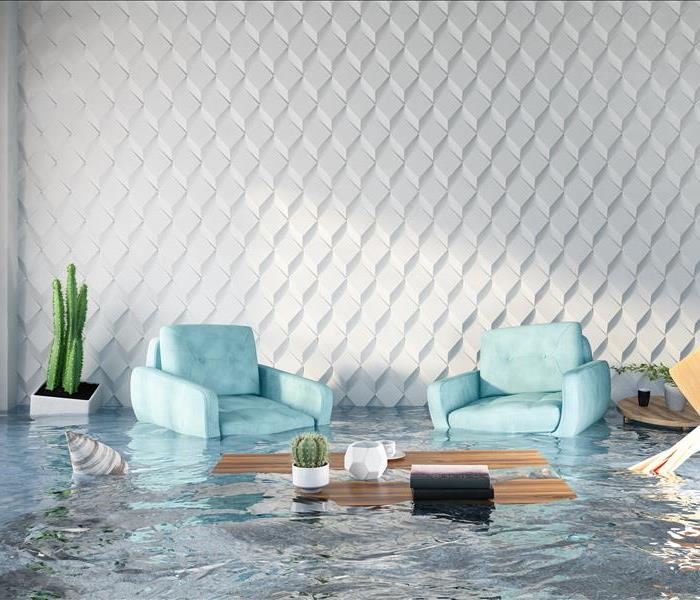Which Daytona Beach Flood Recovery Company Can Best Respond to All Aspects of Storm Damage Including the Discovery of Contaminants During Significant
8/20/2020 (Permalink)
 The team at SERVPRO of North Daytona Beach / Ormond Beach trains for the unexpected during flood damage mitigation and remediation.
The team at SERVPRO of North Daytona Beach / Ormond Beach trains for the unexpected during flood damage mitigation and remediation.
Storm-Related Flood Damage in Daytona Beach Is Overwhelming, Especially When Biohazard and Other Contamination Issues Arise -- SERVPRO Can Manage It All
When tropical storm and hurricane patterns heat up in Daytona Beach, flooding in residences is often not far behind. Dealing with large quantities of water is tough enough, but sometimes the intensity of the flood action causes structural components to break apart. In addition, porous building materials begin to crumble and deteriorate as water infiltrates. The destructive outcomes of forceful water flow and soak-through can reveal previously contained hazardous substances that now might need professional remediation.
What Kinds of Contaminants Are Possible in Flood Waters?
Daytona Beach flood damage can threaten you and your loved ones to significant exposure to materials and organisms determined to have potential adverse health effects. When our highly-trained crew discovers these biohazards, we shift the flood mitigation and remediation focus as needed for the abatement of these harmful materials. Commonly encountered flood-related biohazards include:
Asbestos
Asbestos is a fibrous silicate mineral used for building materials into the 1980s. The substance is found as an insulating covering on furnaces and heating ductwork and as loose or rigid insulation in attics, walls, and ceilings. Textured paint and patching compounds, as well as roofing materials, can contain the hazardous minerals. Some resilient floor tiles contain asbestos. According to the EPA, no level of exposure to asbestos is considered safe, and the material can crumble and become airborne during water exposure and remediation activities.
Lead
Usually found in residences as lead-based paint, the Environmental Protection Agency (EPA) reports that any home built before 1978 probably has lead-based materials somewhere in the house. Lead solder and pipes were used into the 1980s. The toxic metal is linked to negative health and behavioral effects of many kinds. Remediation and restoration efforts can send lead dust into the air and spread it to surfaces when materials disintegrate and crush.
Molds
Flood damage can contribute to mold growth if water and moisture linger for more than 24 to 48 hours. Many homes have hidden mold growth even before a flooding incident, so damage to structural components can expose this concealed biohazard as an unexpected complication when materials are cut away to release trapped water or provide enhanced airflow for drying.
Water-Borne Pathogens
Flood damage frequently includes the chance of exposure to sewage, and a broad range of other debris and materials picked up during overland flooding. Some of the infectious agents mixed into floodwaters can make people very ill and, in some cases, even cause death.
Salt Water Storm Surge
Oceanside communities see seasonal storm damage exacerbated by storm surge frequently. The mix of flooding fluids can include seawater, bringing salts, minerals, sea creatures, marine fuels, and more into your home. Saltwater damages wood, concrete, and metal.
How Can One Restoration Company Manage One or More Biohazard Complications?
SERVPRO invests in advanced biohazard remediation training and licensure for our management and technicians. We know how stressful and disruptive flood damage recovery can be to families in our community. We strive to prepare in every way possible to meet the diverse needs presented by storm-related flood damage. When we encounter biohazards contaminating the environment inside your home during the water removal, cleaning, disinfection, or drying phases of the flood damage restoration project, we take a pause. We consider how to integrate the biohazard abatement into the overall agenda of tasks needed to return your property to function and appearance after flooding. The safety hazards cannot be ignored but must be controlled and remediated appropriately.
What Adaptations Are Needed to Resolve the Biohazard and Contamination Concerns During Flood Damage Recovery?
Containment of the asbestos, lead, and mold-containing spaces are essential during remediation interventions. Our crews use legally sanctioned strategies to prevent the biohazards from escaping and tainting other areas of your home. Wrapping the affected area in 1.6 mil polyethylene and constructing supports from conduits are commonly utilized protocols. The offending materials are removed and contained for disposal following local regulations. Storm surge contamination requires a freshwater flush that increases the quantity of fluids needing extraction but improving the odds of a successful outcome.
The team at SERVPRO of North Daytona Beach / Ormond Beach trains for the unexpected during flood damage mitigation and remediation. For a one-stop storm flooding recovery experience, call (386) 677-9993.






 24/7 Emergency Service
24/7 Emergency Service